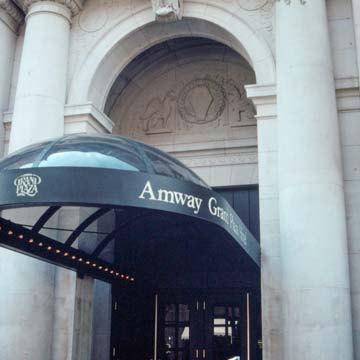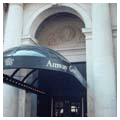You are here
Amway Grand Plaza Hotel (Pantlind Hotel)
Richard M. DeVos and Jay Van Andel of the Amway Corporation in nearby Ada collaborated with the City of Grand Rapids to make Grand Rapids a remarkable contemporary convention center. In developing Amway Grand Plaza, DeVos and Van Andel acquired, remodeled, and redecorated the Pantlind Hotel in the late 1970s to the interior designs of Carleton Varney of Dorothy Draper and Company of New York City. Originally, in 1913–1915, the Pantlind Hotel Company built the hotel with over five hundred rooms on the site of the old Pantlind Hotel (1902), with the assurance that J. Boyd Pantlind (1851–1922), a member of a family of reputable Grand Rapids and Michigan innkeepers, would assume its management, and with the awareness of the demand for hotel accommodations by furniture buyers. The restrained Renaissance Revival building reflects the Ecole des Beaux-Arts training of Warren and Wetmore of New York City, a firm best known for its hotel designs, for Grand Central Station in New York, and for the Michigan Central Railroad Station in Detroit. Then, in 1981–1983, the Amway Corporation built the sleek, 25-story, reflective-glass-sheathed connecting tower, which added 250 more rooms. The angular-sloped terminus to the shaft of the Amway Grand Plaza Tower is a landmark on the skyline. The city improved the riverfront and built skyways, bridges, and pedestrian walkways to connect the hotel, the Civic Auditorium (now replaced by DeVos Place; KT2), and the Gerald R. Ford Museum ( KT29).
Writing Credits
If SAH Archipedia has been useful to you, please consider supporting it.
SAH Archipedia tells the story of the United States through its buildings, landscapes, and cities. This freely available resource empowers the public with authoritative knowledge that deepens their understanding and appreciation of the built environment. But the Society of Architectural Historians, which created SAH Archipedia with University of Virginia Press, needs your support to maintain the high-caliber research, writing, photography, cartography, editing, design, and programming that make SAH Archipedia a trusted online resource available to all who value the history of place, heritage tourism, and learning.


















